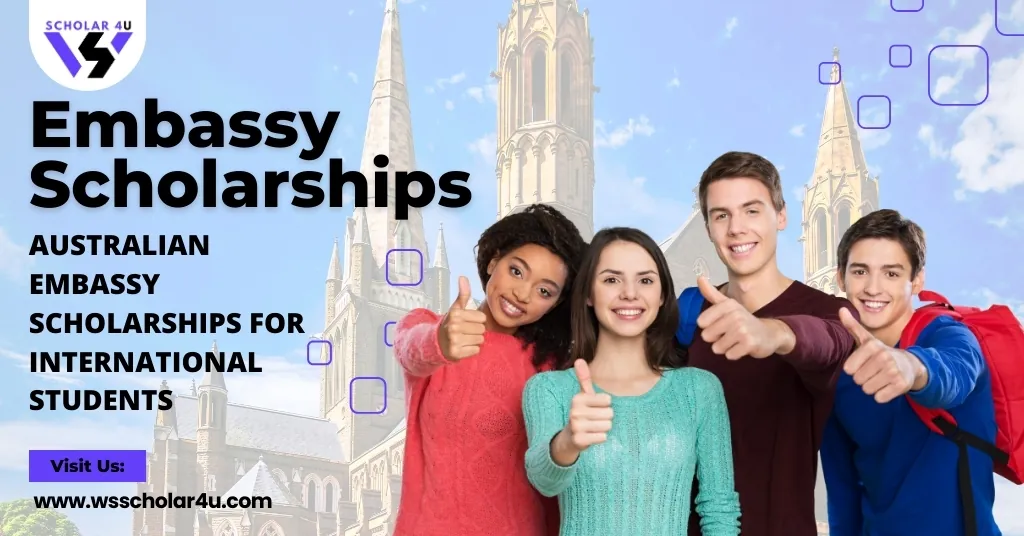My Journey to a Fully Funded Future: Unlocking the Magic of Embassy Scholarships
Hey there, fellow dreamers! Have you ever looked at a map, pointed to a far-off country, and imagined yourself studying there? Maybe learning a new language, diving into a different culture, or just experiencing life far from home? For years, that was my biggest dream, but honestly, it felt like just that – a dream. The cost? Oh boy, that was the giant monster guarding the treasure chest. Tuition fees, living expenses, travel – it all added up to a sum that made my head spin.
But then, something shifted. I stumbled upon a little secret, a hidden pathway that completely changed my perspective: Embassy Scholarships. And let me tell you, discovering them felt like finding a secret door to a world I thought was out of reach. If you’re new to this concept, or if you’ve heard whispers but don’t know where to start, you’re in the right place. Grab a cup of coffee, and let me tell you my story.
What Exactly Are These "Embassy Scholarships" I Keep Talking About?
Picture this: Governments around the world are keen on fostering international relations, promoting cultural exchange, and attracting bright minds to their universities. To do this, many countries offer scholarships specifically for international students – students like you and me – to come and study in their nation. These programs are often managed or facilitated through their respective embassies or consulates in your home country.
Think of it like this: The Japanese Embassy might offer the MEXT Scholarship for students to study in Japan. The German Embassy could be your gateway to a DAAD scholarship. The UK’s Chevening, the USA’s Fulbright, France’s Eiffel – these are just a few of the big names out there. And the best part? Many of these are fully funded scholarships. Yes, you heard that right! We’re talking about tuition fees covered, living allowances, health insurance, and sometimes even flight tickets. It’s truly a life-changing opportunity.
Why They Became My North Star (and Why They Should Be Yours Too!)
Before I knew about embassy scholarships, I was looking at university websites directly, and honestly, the price tags were disheartening. But once I understood what these government-backed programs offered, my motivation skyrocketed. Here’s why they’re so incredible:
- Financial Freedom: This is the big one. No more worrying about student loans or how to pay for rent. With everything covered, you can truly focus on your studies and immerse yourself in your new environment. It lifts an enormous weight off your shoulders.
- World-Class Education: These scholarships often open doors to some of the best universities globally. You get to learn from leading experts and be part of an international academic community.
- Cultural Immersion: It’s not just about books! Living in a new country means experiencing its customs, traditions, food, and people firsthand. It broadens your horizons in ways a textbook never could.
- Networking Opportunities: You’ll meet fellow scholars from all over the world, professors, and professionals. These connections can be invaluable for your future career.
- Career Boost: An international degree, especially from a prestigious scholarship program, looks fantastic on your resume. It shows adaptability, academic excellence, and a global mindset.
- Personal Growth: Stepping out of your comfort zone, navigating a new system, and becoming independent – these challenges shape you into a more resilient, confident, and globally aware individual.
For me, it wasn’t just about getting a degree; it was about transforming my entire outlook on life.
My Journey: From Overwhelmed to Overjoyed
Okay, so I was convinced. This was my path. But where to begin? The sheer volume of information felt like trying to drink from a firehose. Let me break down how I approached it, step by step:
Step 1: The Deep Dive – Research, Research, Research!
My first mission was to figure out which countries offered these scholarships and what their programs entailed. I spent hours on Google, not just typing "scholarships," but specific phrases like "government scholarships for international students," "[Country Name] embassy scholarships," or "fully funded scholarships for [my field of study]."
I learned that each country has its own flagship programs. I started making a list:
- What country?
- What scholarship name?
- What are the general eligibility criteria (age, academic background, citizenship)?
- What’s the application timeline?
Pro-tip: Always, always, always check the official embassy website of the country in your home nation, or the official scholarship program website (e.g., DAAD.de, Chevening.org). Third-party sites can be helpful for initial discovery, but official sources are your gospel.
Step 2: The Self-Assessment – Am I Even Eligible?
This was a crucial, sometimes brutal, step. Each scholarship has specific requirements. Do you need a certain GPA? Is there an age limit? Do you need a specific English language test score (like IELTS or TOEFL)? What about work experience?
I meticulously compared my profile against the requirements of each program on my list. If I didn’t meet a specific criterion, I moved on. This saved me a lot of wasted effort. It’s important to be honest with yourself here. If they say "minimum 3.0 GPA," and you have a 2.5, it’s likely not the right fit for that specific program.
Step 3: The Application Beast – Breaking It Down
Once I found a few scholarships I was genuinely eligible for, the real work began. Applications for embassy scholarships are thorough. They usually require:
- Academic Transcripts & Certificates: Official copies of your past academic records.
- Letters of Recommendation (LORs): Usually from professors or employers who know your work ethic and capabilities. I reached out to my former professors early, explaining my goals and providing them with my resume and a summary of the scholarship.
- Curriculum Vitae (CV) / Resume: A detailed overview of your academic and professional history.
- Study Plan / Research Proposal: This is where you outline what you want to study, why that particular program/university, and how it aligns with your future goals.
- Personal Statement / Essay: This is YOUR story. More on this in a moment!
- Language Proficiency Proof: If studying in an English-speaking country or an English-taught program, you’ll need IELTS/TOEFL. If studying in a non-English speaking country in their native language, you might need proof of proficiency in that language.
- Passport Copy: Standard identity verification.
It felt like assembling a giant puzzle, piece by careful piece.
Step 4: The Heart of the Application – Your Story (The Essay!)
This, believe me, is where you shine. The personal statement or essay isn’t just a formality; it’s your chance to speak directly to the selection committee. It’s not about listing your achievements (your CV does that); it’s about telling the story behind those achievements.
I focused on:
- My Motivation: Why this specific field? Why this country? What sparked my interest?
- My Experiences: How have my past academic or professional experiences prepared me for this? What challenges did I overcome?
- My Goals: How will this scholarship and degree help me achieve my short-term and long-term aspirations? How will I contribute to my home country or the world?
- My "Why Me?": What makes me a unique and valuable candidate? What qualities do I possess that align with the scholarship’s values (e.g., leadership, community involvement, cross-cultural understanding)?
I drafted, revised, and re-revised my essays countless times. I asked friends and mentors to read them and provide feedback. It needs to be authentic, compelling, and free of errors.
Step 5: The Interview – My Palms Were Sweaty!
If your written application makes the cut, you’ll likely be invited for an interview. This was probably the most nerve-wracking part for me. It’s usually conducted by embassy officials or alumni of the program.
My preparation involved:
- Re-reading My Application: Knowing every detail of what I submitted.
- Researching the Country & Scholarship: Understanding their goals and values.
- Practicing Common Questions: "Tell me about yourself," "Why this program?", "What are your weaknesses?", "How do you handle stress?", "What do you know about [Country X]?"
- Thinking of Questions to Ask Them: This shows engagement and genuine interest.
- Dress the Part: Professional attire.
- Practice, Practice, Practice: I did mock interviews with anyone who would listen!
During the interview, I tried to be confident, articulate, and most importantly, myself. I made sure to convey my passion and genuine desire for the opportunity.
Step 6: The Waiting Game – Patience is a Virtue
After submitting everything and completing the interview, there’s nothing left but to wait. This period can be agonizing. I tried to distract myself, focusing on other tasks, but a part of my mind was always checking my email.
And then, one day, it arrived. An email with the subject line that made my heart leap. I had been selected! The feeling was indescribable – a mix of relief, joy, and overwhelming gratitude. My dream, once so distant, was now a reality.
My Biggest Advice for You, Fellow Aspiring Scholars:
If my story has sparked a fire in you, here are my top takeaways:
- Start Early, REALLY Early: These applications are complex and have strict deadlines. Give yourself months, not weeks, to prepare everything.
- Be a Research Whiz: Dig deep into every scholarship opportunity. Understand their mission, their requirements, and what kind of candidates they are looking for.
- Tailor, Don’t Copy-Paste: Never use a generic application. Each essay, each study plan, needs to be specifically crafted for that particular scholarship and institution. They can spot generic applications from a mile away.
- Show, Don’t Just Tell (in your essays): Instead of saying "I am a leader," describe a situation where you demonstrated leadership. Use anecdotes to illustrate your points.
- Cultivate Your Network: Good letters of recommendation are gold. Build relationships with professors and mentors who can genuinely speak to your abilities.
- Practice Your Interview Skills: It’s not just about what you say, but how you say it. Confidence and clarity are key.
- Don’t Get Discouraged by Rejection: The application process is incredibly competitive. You might not get the first one, or the second. Learn from each experience, refine your approach, and keep trying. Persistence is your superpower.
- Proofread Everything: A typo or grammatical error can make a bad impression. Have multiple sets of eyes review your application documents.
Your Adventure Awaits!
Embassy scholarships aren’t just about funding your education; they’re about investing in your future, opening up a world of possibilities, and becoming part of a global community. My journey taught me that with enough research, dedication, and a sprinkle of courage, even the most daunting dreams can become tangible realities.
So, if you’re dreaming of studying abroad but the financial hurdle seems too high, remember my story. Start researching, start preparing, and start believing. That secret door to a fully funded future might just be waiting for you to knock. Good luck, and happy exploring!



